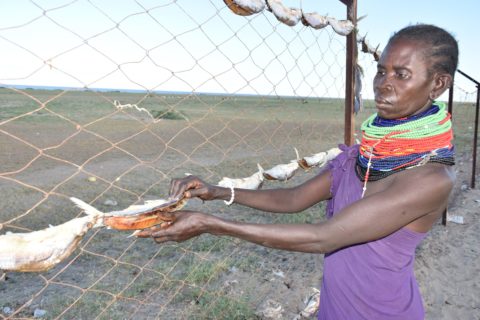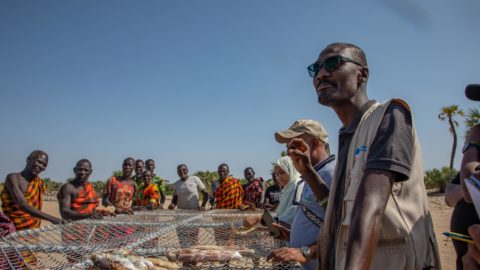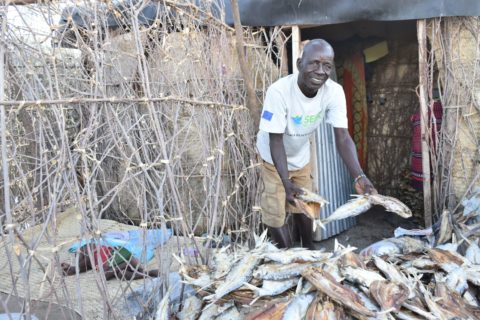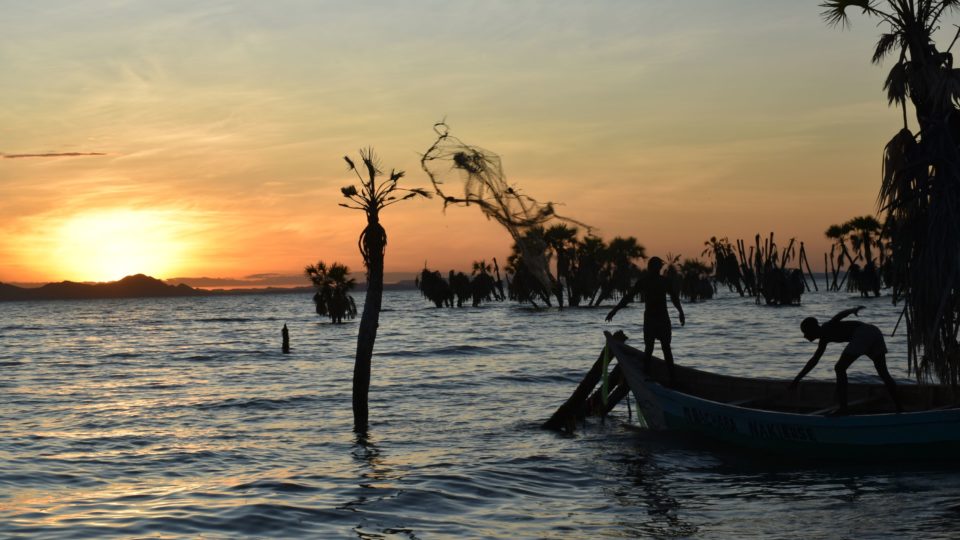Lake Turkana is Kenya’s biggest and Africa’s fourth largest lake. Nestled on the border of Kenya and Ethiopia, its basin extends into southeastern South Sudan and parts of eastern Uganda. River Omo, which flows down the Rift Valley from the western Ethiopian highlands, is its main inlet with an inflow of 90 per cent.
An oasis in the middle of Kenya’s arid and semi-arid north, Lake Turkana is the world’s largest permanent desert and alkaline lake. It is home to over 60 fish species, ten of which are native to the Lake, with Nile tilapia and Nile perch being its most valued fishery species.
Cultural inhibitions – the pastoralist Turkana do not traditionally engage in fishing, except in times of extreme drought – and limited resources for investment have hindered the full exploitation of this resource, yet this would diversify livelihoods and buffer the community from the rising impacts of climate change.
Wetlands International, therefore, initiated a pilot project to support sustainable fisheries in the Omo-Turkana landscape in collaboration with the fisher folk, the Turkana County Government Fisheries Department, Beach Management Units (BMUs), Turkana Pastoralists Development Organisation (TUPADO), and local administrators.
The intervention involved the installation of fish racks measuring 240m by 2.5m by 1.8m and capacity building and awareness to foster sustainable fishing and improve the livelihoods of approximately 387 households in Kampi County village in Todonyang. The Lokipetot BMU and Ekosowan landing sites, which are not in Todonyang, also received fish racks.
Fish Preservation infrastructure
This activity was based on findings of several field excursions where 70 landing sites and 1,021 ha of breeding sites were mapped. The excursions revealed that hundreds of households involved in fishing in Todonyang lacked fish drying infrastructure.

Selina Nanyang hanging fish to dry on a perimeter fence in Todonyang, Turkana
“I’m over 40 years old and my life revolves around fish. I spend my days putting out fish to dry. As we did not have any other means, we would dry out our fish along the perimeter fence around our homes and on the bare ground,” says Selina Nanyang, Todonyang resident.
Besides being unhygienic, this drying method grossly reduced the fish’ market value due to sand particles embedding into the harvested fish. In addition, this project aimed at improving health at the household level through the consumption of better quality, unspoiled fish.
Unsustainable fishing practices were also observed including undersized fishing using monofilament nets, fishing along breeding sites, and illegal fishing in protected areas. This harms biodiversity and lowers the rate of fish stock regeneration. The fisher folk also complained of poor returns from the sale of fish and BMU boundary-related conflicts.

Drying fish racks are a simple and viable means to achieve sustainable fisheries in Lake Turkana
According to Selina, the racks have helped to reduce sand on the fish and the fish dries faster and evenly. “Also, theft of fish has reduced as we sometimes choose to sleep under the racks. Before, we would get discouraged due to loss of fish. We are still hopeful for more racks as there is lots of fish here,” she adds.
Observations
Further observations made were that there was resistance from a portion of the fisher folk who found fishing undersized fish within breeding sites much easier than venturing deeper into the Lake. This is a challenge that can be managed through increased outreach and awareness, and stringent enforcement by BMUs, County fisheries officials, and other state agencies.
Also, the mesh first selected for the fish racks was prone to rusting even after painting. This was not foreseen when choosing materials for constructing the fish racks. These racks were, however, replaced with stainless steel mesh, which should be the standard when building new fish racks in the future.
Finally, the community at some landing sites preferred movable fish racks due to the fluctuation of the Lake’s water levels, and not the fixed fish racks that were installed in Todonyang. In addition, BMUs made an appeal for cold storage facilities that are solar-powered, hence climate friendly, energy-efficient and cost-effective.

Shadrack Nakorumor – Todonyang BMU Vice Chair
“We are grateful for Wetlands International’s support with training on sustainable fishing practices and the drying racks. Our fish drying needs are huge because we have about 60 boats in Todonyang and the racks can only take up limited fish. We request for more to ensure better hygienic conditions,” says Shadrack Nakorumor, Todonyang BMU Vice Chair.
Lessons Learnt
Firstly, in resource-scarce regions, inter- and intra-community conflicts flare up easily. Community engagement is therefore paramount, as there is a risk of conflict if all stakeholders, especially the government and all segments of the community, are not involved.
Secondly, comprehensive community engagement enabled us to tap local knowledge on the most preferred type of fishing racks and which landing beaches offered the best harvests and were therefore best suited for the project. Communities also understand the different fish species and that drying methods differ depending on the type of species.
Thirdly, it is critical, as part of community engagement, to create awareness of the impact of unsustainable fishing practices, particularly the use of illegal nets and fishing in breeding areas. With training, BMUs can play a crucial role here, especially if their efforts are supplemented by the relevant law enforcement agencies.
This blog is adapted from a case study developed by Paul Ekwar, Titus Wamae, Priscilla Kagwa and Edmond Kuto on the Source to Sea Wetlands Eastern Africa Wetland Initiative

